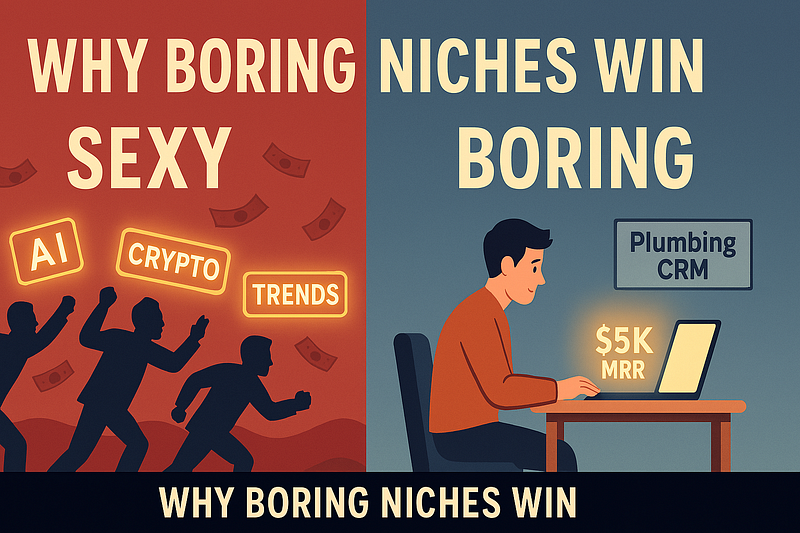Boring Is the New Sexy: Why “Boring” Niches Are a Founder’s Secret to $5K MRR Success
Early-stage entrepreneurs often chase the latest “sexy” trend — the flashy tech or hot consumer app everyone’s talking about. But if your…

Early-stage entrepreneurs often chase the latest “sexy” trend — the flashy tech or hot consumer app everyone’s talking about. But if your goal is sustainable revenue (say, reaching that first $5K MRR in 2025), a contrarian approach might serve you better: go boring. In this article, we’ll explore what boring vs. sexy niches really mean, why boring niches can drive stronger traction and retention, and how principles from Blue Ocean Strategy — like value innovation and finding competition-free market space — support this approach. We’ll look at case studies of entrepreneurs who quietly triumphed in “unsexy” markets, share frameworks for identifying high-opportunity boring niches, and provide practical prompts to help you zero in on your niche.
Boring vs. Sexy Niches: What Do We Mean?
Boring niches refer to markets or problem domains that are unglamorous, overlooked, or old-school — think industries or customer segments that don’t make TechCrunch headlines. These are often high-demand areas with low innovation or competition. Sexy niches are the trendy, hyped spaces — blockchain, AI-driven social apps, cutting-edge consumer gadgets, etc. Everyone wants in on these, which means they’re crowded with competitors and noise.
A classic example: Amazon’s origin story. Jeff Bezos didn’t start with flashy tech — he started with selling books online. Bookselling wasn’t glamorous, but it was a huge market ready for innovation. Books were boring. But they were profitable.
Why Boring Niches Often Offer Better Traction and Revenue
1. Less Competition
Boring niches have fewer startups fighting for attention. Instead of being the 50th crypto app, you might be the only modern solution for municipal park management or auto repair shop scheduling.
2. Real Problems = Eager Customers
These niches usually involve real pain points — manual processes, outdated software, lack of automation. Solve these, and you’re not just another tool — you’re a hero.
3. Higher Retention
Customers stick around because you deeply understand their specific needs. There are fewer alternatives, so good service = long-term MRR.
4. Lower Acquisition Costs
When your audience is narrow and well-defined, your marketing becomes more effective and cheaper. You can go deep instead of wide.
5. Resilient Demand
Boring niches often relate to essential services — accounting, compliance, logistics. These don’t go out of fashion, even in recessions.
Case Studies: Entrepreneurs Who Won Big by Going “Boring”
- Vertical SaaS in Unsexy Industries: Founders who build tools for dentists, senior care homes, or trucking companies often report strong MRR and little competition.
- Rob Walling’s Playbook: Walling grew and sold multiple SaaS products in “boring” markets by picking niche problems and executing consistently.
- Lead Gen for Senior Living: Some entrepreneurs make six figures a month selling leads to elder care facilities — high demand, low flash.
- Content for Boring Domains: Writers and bloggers focused on medical equipment or B2B finance often earn more than lifestyle or travel writers due to specialized demand.
- Productized Services: Agencies that specialize (e.g. websites for plumbers, email marketing for chiropractors) grow faster by being experts in one narrow domain.
How to Identify a High-Opportunity Boring Niche
1. Look for Outdated Processes
Find workflows still using fax machines, paper forms, or 1990s software. These scream opportunity.
2. Leverage Your Experience
Have you worked in retail, healthcare, logistics? You may already know of inefficiencies to fix.
3. Listen for Complaints
Search Reddit, forums, Facebook groups. Complaints about existing tools are your product roadmap.
4. Ensure Good Economics
Are there enough customers willing to pay? Can you realistically reach $5K MRR with 50–100 clients?
5. Use the S.O.W.S. Framework
- Stale: No recent innovation
- Old: Market has existed for years
- Weak: Competitors are few or bad
- Simple: Solvable with basic tech or systems
6. Talk to Customers
Validate your assumptions early. If people say, “I’d pay for that,” you’re on the right track.
Apply Niche-First Thinking to Any Business Model
- SaaS: Build vertical-specific tools (e.g. invoicing software for fitness coaches).
- Content: Make blogs or YouTube channels that dominate narrow topics (e.g. commercial lawn care marketing).
- Services: Specialize in one type of client (e.g. PPC ads for roofers).
Questions to Ask When Choosing Your Niche
- Who do I want to help, and what painful problem do they have?
- What annoying process have I seen firsthand?
- Are people spending money/time to solve this now?
- Can I easily reach and speak to these customers?
- Is the audience big or valuable enough to sustain $5K+ MRR?
- What makes me different from existing solutions?
- Can I stick with this niche for years?
Small Niche, Big Opportunity
Boring niches don’t get the spotlight, but they quietly produce real revenue. They let you own a small market and serve it better than anyone else. If your 2025 goal is $5K MRR, going boring might be your smartest move. There’s less noise, more focus, and often, more money. The best part? You can build quietly, consistently, and sustainably — no hype required.
So next time you hear about the next big AI thing, maybe skip it. Instead, talk to a roofer, a dog groomer, or a funeral director. You might find gold where no one else is looking.
Dare to be boring. Your bank account will thank you.





